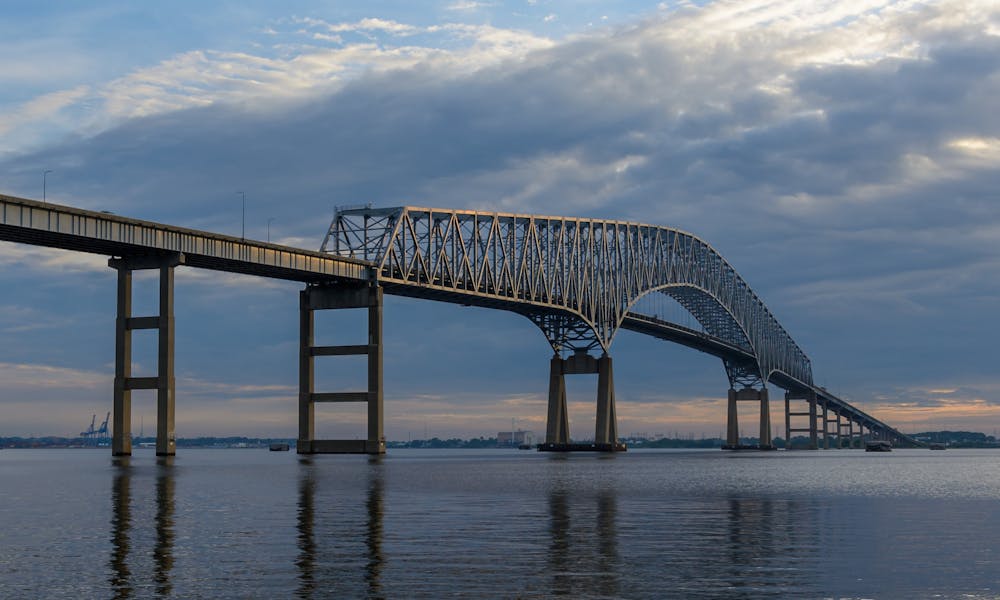On March 26 at about 1:30 a.m., the cargo ship Dali struck the Francis Scott Key Bridge, causing a disastrous collapse that sent shockwaves through the city of Baltimore and the structural engineering community nationwide. Questions arose about the safety of the bridge and how such a disastrous event occurred. Multiple Hopkins experts were contacted for information on the technical aspects of the collapse. Francis Scott Key was the second longest continuous-truss bridge in the U.S. and the third in the world.
My deepest condolences go out to the families of those lost in the collapse. Shedding light on what caused such a catastrophic disaster is critical to ensuring that such a failure doesn’t occur again.
Rachel Sangree, director of undergraduate studies and associate teaching professor in the Department of Civil and Systems Engineering, shed light on the incident in an interview with The News-Letter. She offered insights into its causes and the implications it carries for bridge infrastructure across the U.S.
“[In engineering], we learn more from failures than we do from successes, but failures on this scale are so difficult to stomach, especially when they involve a loss of human life,” she said, highlighting that the tragedy was deeply personal to the city of Baltimore.
According to Sangree, a key contributor to the Key Bridge collapse was age, not due to deterioration but due to the time since construction. Construction on the bridge began in 1972 and the bridge opened to the public in 1977. This was directly before the 1980 collapse of the Sunshine Skyway Bridge in Tampa Bay, which was caused by a freighter hitting a support column and resulted in 35 fatalities.
The collapse prompted a significant change of bridge design codes and structural considerations for bridges. New bridges were required to be designed to withstand the impact force that a ship can deliver or to protect the bridge against that impact force. In the case of the Sunshine Skyway Bridge, engineers put “dolphins” in place, structural bumpers along the main span to protect the supports.
Legislature never required older bridges to be fortified or replaced, however. The Key Bridge’s supports were thus not built to withstand the immense impact from the Dali. Additionally, the circumstances surrounding the collapse were simply extraordinary due to the unpredictability of the Dali’s crash and its trajectory directly towards one of the bridge’s key supports.
"It [was] sort of a perfect storm of a vessel losing power... as it was approaching an under-protected part of a bridge,” Sangree explained.
The collapse of the Key Bridge raised questions about the considerations that engineers will take into account when rebuilding the bridge. The primary factor identified by Dr. Sangree was the integration of an even longer span length. Though supports are critical for a bridge, the span between these supports must be strong enough to carry the loads. Long spans are justified in bridges such as the Key Bridge, where space for a support is limited — such as if a bridge is located over a deep body of water.
Because of its proximity to deep water, adding more supports would be a difficult and expensive task, so lengthening the span would be more economical. Adding dolphins and refortifying existing supports could also be a potential improvement. A replacement bridge may also be a different kind of bridge; some experts suggest that a cable-stay bridge may be more likely to be built than the previously constructed continuous-truss bridge because of how it fits with the needs and aesthetics of a modern city.
This tragedy is made even more important because of the Key Bridge’s emotional significance. The bridge holds great historical symbolism; it is said to be located within 100 yards of where Francis Scott Key was kept aboard on the British flagship HMS Tonnant and wrote his famous poem that eventually became the national anthem. Additionally, the bridge was vital to the livelihoods of hundreds of working-class Americans who depended on the bridge as a route of daily commute.
“Some people built their lives around that bridge,“ Sangree said.
The collapse raised many questions about how to prevent such disasters and the implications this has for infrastructure investment more broadly.
“We need to be investing more in infrastructure,“ Sangree said. “We need to be investing proactively rather than reactively.”





